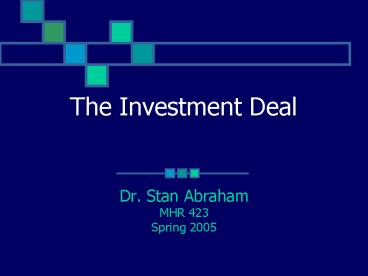The Investment Deal - PowerPoint PPT Presentation
1 / 13
Title:
The Investment Deal
Description:
Seed capital to prove the concept is viable. Startup capital to make the ... Startup Capital. Typically funded by venture capitalists or angel investors ... – PowerPoint PPT presentation
Number of Views:18
Avg rating:3.0/5.0
Title: The Investment Deal
1
The Investment Deal
- Dr. Stan Abraham
- MHR 423
- Spring 2005
2
Stages of Financing
- Early-stage financing (highest risk)
- Seed capital to prove the concept is viable
- Startup capital to make the business
operational - Expansion financing (lower risk)
- Second-stage financing first commercial sales
- Third-stage financing rapid expansion
- Fourth-stage financing to go public
3
Seed Capital
- Highest risk (no assurance of success, long time
before revenues are achieved) - Sources typically include relatives and
entrepreneurs own capital - Needed typically for RD
- To prove the concept
- To develop a working prototype
- VCs wont invest at this stage
- Biotech companies were an exception
4
Startup Capital
- Typically funded by venture capitalists or angel
investors - They require ROIs of 40-200
- High ROI required in part to offset an average
80 failure rate - Proceeds typically used for
- Marketing (expansion)
- Operations or production (expansion)
- Continued RD
- Staffing
5
Subsequent-Stage Financing
- Typically provided by venture capitalists,
investors, investment banks, corporations - Multiple investors common (to share risk when
investment required is too large ) - Required ROIs in the 25-100 range
- Proceeds typically used for marketing, systems,
new product development, expansion, and brand
development
6
Equity Financing
- Company must be valued first (value is often
estimated) so a value can be placed on the shares
owned by the investor - The investor gets
- An equity stake in the company (percentage is
negotiated) - A seat on the board of directors
- Investment does not have to be paid back
- Risk is borne by the investor(s)
- Investment is for a limited time (about four
years)
7
Investment-Deal Terms
- Capital requested
- Percentage of the company given in exchange
- Uses of the proceeds
- Exit strategy (how would the investment be
recouped and when?) - Other conditions
- For example, stock buybacks based on achieving
agreed upon performance milestones
8
Will an Investor Invest?
- Depends on how attractive the deal is
- Depends on how strong the business model is
- Depends on the level of trust the entrepreneur
can command (usually more with more experience)
(chemistry) - Depends on how seductively the business plan is
written
9
Loan Terms from Banks
- Loan amount
- For how long? When will it be repaid?
- At what monthly payment? What interest rate?
- What is offered as collateral?
- When is the money needed and when will the first
payment begin? - Other conditions
10
Loan Terms (cont.)
- Investors or relatives not just banks can
also lend you money - Offer an interest rate that would induce them to
lend (double the banks?) - Negotiate the term of the loan and how it would
be repaid - No collateral is typically required
- Make sure the terms of the loan are put in
writing and agreed upon (both parties sign)
11
Non-Collateral Loans from Banks
- Conditions that must be met
- Company must have been in business three years
- Two of those years must have shown a profit
- Principal must have good character, credit
rating, and no criminal record
12
Exit Strategy
- This is when everyone cashes out
- Often at an IPO (initial public offering)
- Company goes public
- Equity financing received from the public
offering pays off the owners and investors of
record - Could be acquired by another company
- Business plan must indicate when this might
happen - Proceeds go to the owners in proportion to the
number of shares they own
13
Any Questions?































